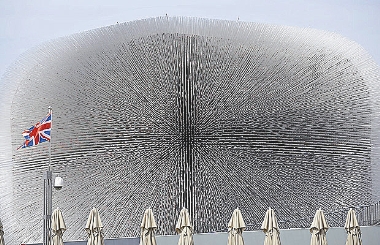
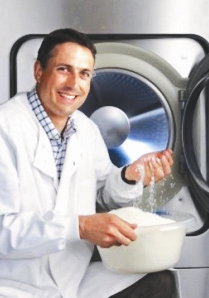
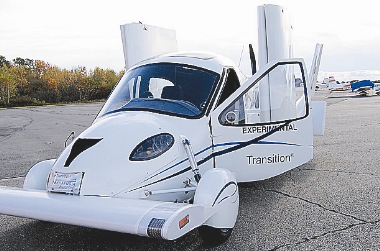
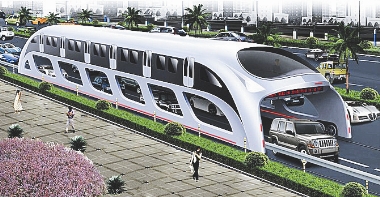
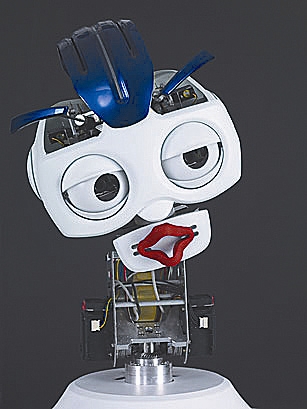
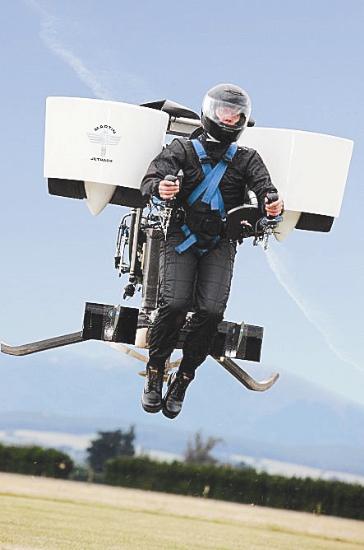
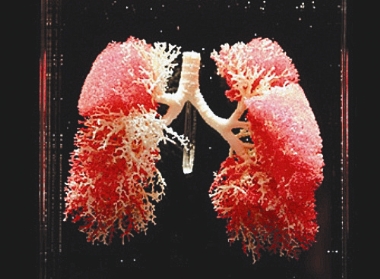

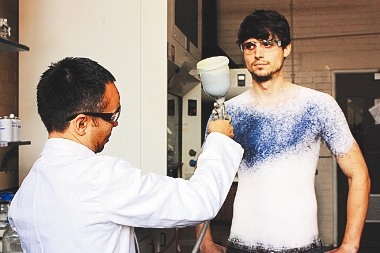

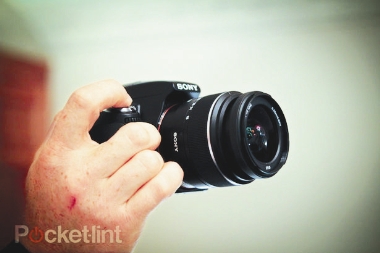
Spray-on fabric A liquid mixture developed by Imperial College London and a company called Fabrican lets you spray clothes directly onto your body, using aerosol* technology. After the spray dries, it creates a thin layer of fabric that can be peeled off, washed and reworn. The spray-on fabric consists of short fibers that are combined with polymers to bind them together and a solvent* that delivers the fabric in liquid form. The solvent evaporates* when the spray touches the surface. The fabric is formed by cross-linking fibers, which cling to one another to create the garment. The spray can be applied using a high-pressure spray gun or an aerosol can. The texture of the fabric changes according to the type of material — such as wool or linen — and how the spray is layered on the body. It can be used to layer bandages on the skin without disturbing* the wound. The Seed Cathedral British designer Thomas Heatherwick creates a house of worship for biodiversity* at 2010 Shanghai Expo. The U.K. Pavilion, otherwise known as the Seed Cathedral, is 20 meters in height, formed from 60,000 slender transparent rods, each 7.5 metres long and each encasing one or more seeds at its tip. During the day, they act as optic fibers and draw daylight inwards to light up the interior. At night, light sources inside each rod allow the whole structure to glow. As the wind moves past, the building and its optic “hairs” gently move to create a dynamic effect. Waterless washing machine A washing machine that cuts water usage by 90 percent is due to hit American stores next year. The Xeros washing machine cleans clothes using reusable nylon polymer beads* with an inherent polarity that attracts stains. The beads are added to the wash along with as little as a cup of water and a drop of detergent*. After the water dissolves the stains, the beads, which become absorbent under humid conditions, soak up the water along with the dirt. The dirt is not just attracted to the surface, but is absorbed into the center of the beads. The beads are removed automatically within the machine at the end of the load. They also don’t require cleaning and can last for about six months of average family usage. eLegs Exoskeleton ELegs is a wearable bionic device that uses a gesture-based human-machine interface to determine how the users want to move and then acts accordingly*. Utilizing a series of sensors, a real-time computer draws on the user’s input information to facilitate every aspect of a single stride. The prototype enables the user to walk in a straight line, stand from a sitting position, stand for a period of time, and sit down from a standing position. Weighing only 20 kilos, the device is easy to put on and transport. iPad How does Apple keep out-inventing the rest of the tech industry? Often, it’s by reinventing a product category that its competitors have given up on. In theory, the iPad is merely a follow-up to such unpopular slate-style computers as Microsoft’s Tablet PC. But Apple is the first company that designed finger-friendly hardware and software from scratch* rather than stuffing a PC into a keyboardless case. One analyst says the iPad is the fastest-selling nonphone gizmo* in consumer-electronics history. Martin Jetpack Martin Jetpack is the first jetpack in the market. Driven by a pair of washing machine-sized fans strapped* to your back, this personal transporter will give you 30 minutes of flight time and comes with a bunch of redundancy systems to ensure any mistakes don’t turn fatal. The rotors are made of a carbon/Kevlar composite and are powered by a two-liter V4 two-stroke engine capable of delivering 200hp (or 150kW). Gas is the fuel of choice. It costs US$86,000. Sony Alpha A55 camera The camera never blinks. Traditional digital SLR cameras have a technical limitation: when you snap a picture, the mirror that’s been redirecting the image to your eye and to a focusing sensor pops up momentarily as the image is captured. Until it goes back down, the camera can’t focus. Sony’s Alpha A55 fixes that with a translucent mirror that stays put. That means you can shoot up to 10 perfectly focused photos a second and record HD video that never goes blurry*. Due to a shortage of English teachers, some South Korean schools have begun experimenting with robotic instructors which look a little like cartoon characters. The program will cost approximately US$45 million to place robotic teaching assistants in preschools and kindergartens. The robots teach via voice-recognition and long-distance learning technology. Lab-grown lungs Two new lab-grown versions of lungs may one day serve as a way to sidestep both animal testing and organ transplant. One engineered rat lung, described in Science Express on June 24, successfully helped rats breathe for brief periods. Biologist Laura Niklason of Yale University and her colleagues first treated adult rat lungs with detergent solutions to remove their cellular components. The team then repopulated the lungs with epithelial* and endothelial* cells from rat lungs, which grew over the scaffolds* to create brand-new lungs. The straddling bus The straddling bus is a combination bus/train that would straddle* the road so cars could drive underneath. It runs on electricity or solar energy. Passengers would sit on the top level (the bus can accommodate 1,200 to 1,400 people) while cars drive beneath them. Its creators claim the straddling bus could reduce traffic jams by 25 to 30 percent, partly by getting people out of their cars and partly because the bus would move along with the cars underneath it rather than being one more vehicle on the road. Terrafugia Transition Transition is a car that can fly. If, while in flight, the craft meets bad weather, the pilot can land and continue on his way on the ground. At destination* airports the pilot can fold the wings and drive off the airfield. The Transition can take off or land at any general aviation airport with at least 760 meters of runway. Once on the ground, its wings require only 30 seconds to fold. At the same time, the vehicle shifts engine power to the front wheels. It runs on gas. With its wings folded, the Transition fits in a single car garage. | 
